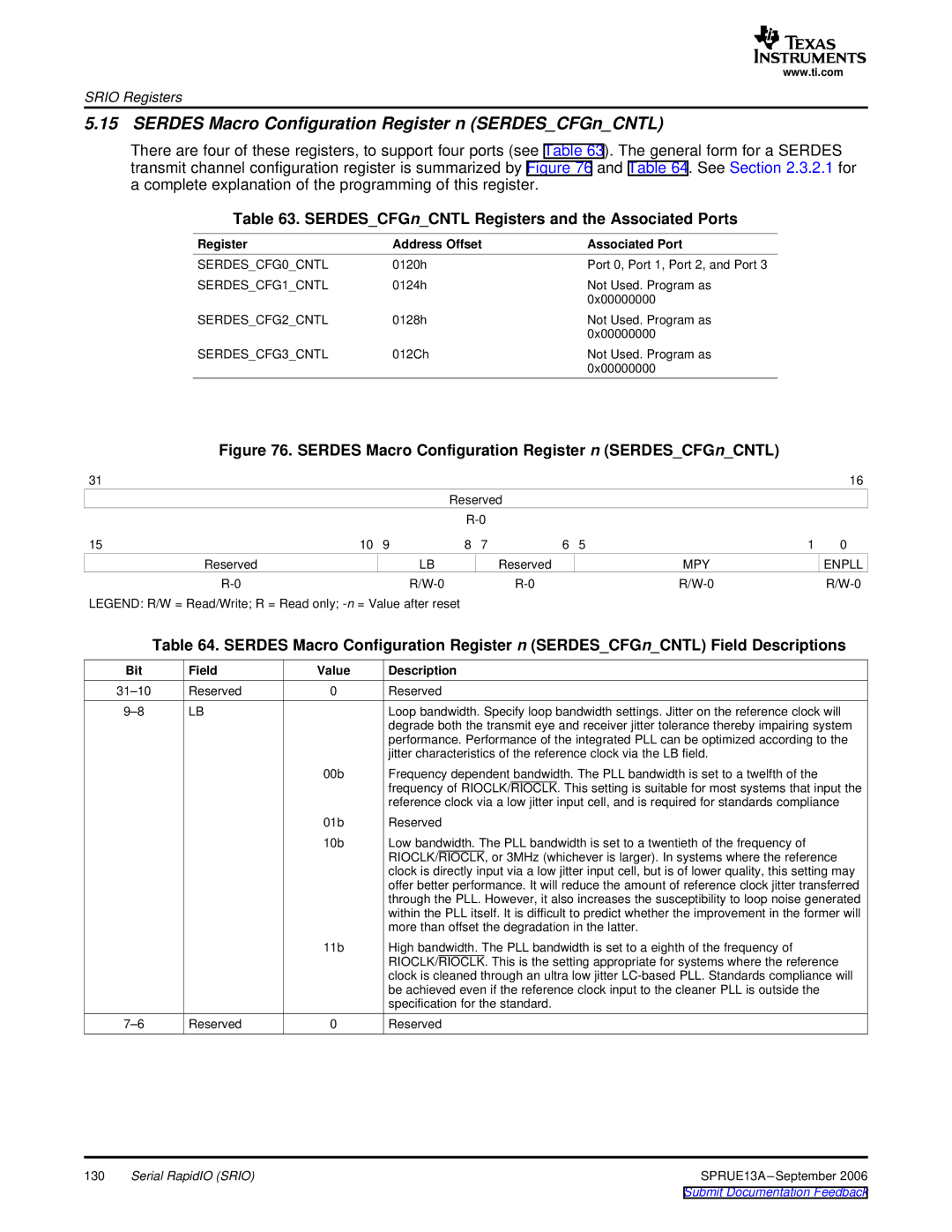
www.ti.com
SRIO Registers
5.15 SERDES Macro Configuration Register n (SERDES_CFGn_CNTL)
There are four of these registers, to support four ports (see Table 63). The general form for a SERDES transmit channel configuration register is summarized by Figure 76 and Table 64. See Section 2.3.2.1 for a complete explanation of the programming of this register.
Table 63. SERDES_CFGn_CNTL Registers and the Associated Ports
Register | Address Offset | Associated Port |
SERDES_CFG0_CNTL | 0120h | Port 0, Port 1, Port 2, and Port 3 |
SERDES_CFG1_CNTL | 0124h | Not Used. Program as |
|
| 0x00000000 |
SERDES_CFG2_CNTL | 0128h | Not Used. Program as |
|
| 0x00000000 |
SERDES_CFG3_CNTL | 012Ch | Not Used. Program as |
|
| 0x00000000 |
Figure 76. SERDES Macro Configuration Register n (SERDES_CFGn_CNTL)
31 |
|
|
|
|
|
|
| 16 |
|
|
| Reserved |
|
|
|
| |
|
|
|
|
|
|
| ||
15 | 10 | 9 | 8 | 7 | 6 | 5 | 1 | 0 |
Reserved |
| LB |
| Reserved |
|
| MPY | ENPLL |
|
|
|
| |||||
LEGEND: R/W = Read/Write; R = Read only;
Table 64. SERDES Macro Configuration Register n (SERDES_CFGn_CNTL) Field Descriptions
Bit | Field | Value | Description |
Reserved | 0 | Reserved | |
LB |
| Loop bandwidth. Specify loop bandwidth settings. Jitter on the reference clock will | |
|
|
| degrade both the transmit eye and receiver jitter tolerance thereby impairing system |
|
|
| performance. Performance of the integrated PLL can be optimized according to the |
|
|
| jitter characteristics of the reference clock via the LB field. |
|
| 00b | Frequency dependent bandwidth. The PLL bandwidth is set to a twelfth of the |
|
|
| frequency of RIOCLK/RIOCLK. This setting is suitable for most systems that input the |
|
|
| reference clock via a low jitter input cell, and is required for standards compliance |
|
| 01b | Reserved |
|
| 10b | Low bandwidth. The PLL bandwidth is set to a twentieth of the frequency of |
|
|
| RIOCLK/RIOCLK, or 3MHz (whichever is larger). In systems where the reference |
|
|
| clock is directly input via a low jitter input cell, but is of lower quality, this setting may |
|
|
| offer better performance. It will reduce the amount of reference clock jitter transferred |
|
|
| through the PLL. However, it also increases the susceptibility to loop noise generated |
|
|
| within the PLL itself. It is difficult to predict whether the improvement in the former will |
|
|
| more than offset the degradation in the latter. |
|
| 11b | High bandwidth. The PLL bandwidth is set to a eighth of the frequency of |
|
|
| RIOCLK/RIOCLK. This is the setting appropriate for systems where the reference |
|
|
| clock is cleaned through an ultra low jitter |
|
|
| be achieved even if the reference clock input to the cleaner PLL is outside the |
|
|
| specification for the standard. |
Reserved | 0 | Reserved |
130 | Serial RapidIO (SRIO) | SPRUE13A |
